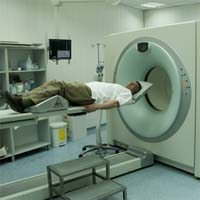Tracking Mesothelioma with FDG-PET

The imaging method called positron emission tomography (PET) using the radioactive tracer molecule 18F-FDG is a valuable way to both diagnose and track the progression of malignant peritoneal mesothelioma.
Nuclear medicine researchers at a Hospital in Barcelona, Spain reviewed the diagnostic and treatment records of 60 people with malignant peritoneal mesothelioma, a form of mesothelioma that spreads on the membrane lining the walls of the abdomen. The study subjects included 34 women and 26 men with a mean age of 53. All the patients in the study had had multiple 18-F-FDG-PET scans to diagnose or track their cancer.
Eleven of the studied patients had an FDG-PET scan prior to receiving treatment. In all cases, the scans showed characteristic mesothelioma disease patterns. Four of those patients had another scan within six months after treatment and the researchers report that those scans were all accurate in determining the patients’ response to treatment.
But even mesothelioma patients who had not had a baseline pretreatment scan benefited from the use of FDG-PET as a way to monitor their disease. The research team says the imaging method was 82% accurate in detecting either the presence or absence of mesothelioma. For 15 people who had negative FDG-PET scans, “a second follow up scan accurately detected disease recurrence or absence of recurrence in all cases”.
One mesothelioma fact they learned from the FDG-PET scans was that people with biphasic mesothelioma – a rarer variety of the disease – were more likely to show signs that the cancer had spread beyond the abdominal lining to other parts of the body. Patients with the more common epithelial subtype of mesothelioma were more likely to have disease that was confined to the peritoneum. FDG-PET scans showed no relationship between the pattern of cells absorbing the FDG tracer molecule and mesothelioma subtype.
Lead author Anna Domenech-Vilardell and her colleagues conclude that 18F-FDG-PET is an excellent way to evaluate peritoneal mesothelioma patients prior to surgery and deserves further study. Their findings were published in April in the Quarterly Journal of Nuclear Medical Imaging, an Italian medical journal.
Source:
Domenech-Vilardell, A et al, “Clinical utility of 18F-FDG Positron Emission Tomography in malignant peritoneal mesothelioma, April 14, 2014, The Quarterly Journal of Nuclear Medicine and Molecular Imaging, Epub ahead of print





